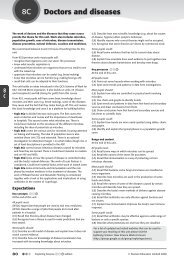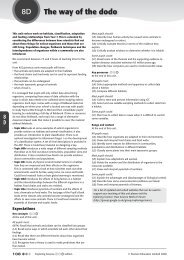8E TEACHER GUIDE.pdf - swallowhillresources
8E TEACHER GUIDE.pdf - swallowhillresources
8E TEACHER GUIDE.pdf - swallowhillresources
- No tags were found...
Create successful ePaper yourself
Turn your PDF publications into a flip-book with our unique Google optimized e-Paper software.
<strong>8E</strong>cSalt of the Earth<strong>8E</strong>cTopic task plannerUse these tasks to adapt the Exemplar topic plan to your own needs. Many tasks can be adapted to become different types (e.g. ‘starter’rather than ‘exploring’). AT or AB/AT at the top of a task means that the task depends on using the ActiveBook and/or ActiveTeach;where these symbols appear in brackets it indicates that the task can be carried out with or without their use.Also consider using one of the plenaries from the previous topic as a starter task in this topic.Task Level NC Type Objectives Skills 1 KC 2 KP 3 RC 4 COStarter 1 M/S 4 Practical 2 PLTS (Ct) 1a 2aStarter 2 M/S 4 Practical 1, 6 2aExploring 1 M/S 4–5 Practical 1-3 1a, 1b, 1c, 2a, 2b, 2aExploring 2 M/S/C 4–5 Practical 2, 3, 5 1b, 1c, 2a 2aExploring 3 M/S 4–5 Practical 1, 6 1a, 1b, 1c, 2a, 2b, 2aExploring 4 M/S 4–5 Classwork 1 ICT (SS), Num (B) 2aExplaining 1 M/S 4 Practical 3 1c 2aExplaining 2 M/S 4–5 Classwork 1, 2, 4, 6 2a cExplaining 3 M/S 5–7 Practical 1, 6 PCTS (Tw) 1a, 1c, 2a, 2b, 3a 2a aPlenary 1 M/S 4–5 Classwork 2, 3, 5 2aPlenary 2 M/S 4–5 Classwork 2, 3, 5 1b 2b 2aPlenary 3 S/C 5–6 Classwork 2, 4 2a cPlenary 4 M 4–5 Classwork 1, 2, 4, 6 Lit (WF) 2aHomework 1 M 4–5 Homework 1 Num (B) 2b 2aHomework 2 S 4–5 Homework 1, 6 Lit (EC) 2b 2a cHomework 3 C 5 Homework 7 Lit (EC) 2a c, kStarters1: Practical: Separating sand and saltShow pupils a small pile of salt, then mix it with some sand and askpupils to work in small groups to suggest a way of separating thesalt and sand again.• Must: show pupils a beaker of water, filtering and heatingapparatus to act as a hint.• Should: pupils should work out a method without seeing theapparatus.Pupils will have allowed solutions to evaporate to dryness at KS2,but may not remember the details of what they did, or have hadthe opportunity to heat a solution to obtain a dissolved solid. Eye protection must be worn when heating.ResourcesSalt; sand; beaker of water; heating apparatus; eye protection.2: Practical: Hard water (demonstration)Put pupils into groups and give each group samples of hardwater and soft water mixed with soap solution. Put this intocontext by telling them that the different samples have come fromdifferent parts of the country. Ask the groups to shake the tubesand to comment on what they observe. Elicit the idea that thetwo samples of water must have different chemicals dissolved inthem, and ask for suggestions as to how this can be determined. Ifnecessary, ask what will happen if the water is heated. Pupils willhave allowed solutions to evaporate to dryness at KS2, but may notremember the details of what they did, and may not have had theopportunity to heat a solution to obtain a dissolved solid.Resources (per group)Samples of hard and soft water; soap solution; boiling tubes.If you are in a hard water area, use distilled water for your softwater. If you are in a soft water area, add approximately 0.45 gof calcium sulphate per litre of water to make up the hard watersample.Exploring tasks1: Practical: Investigating waterPupils analyse three or more different water samples to determinehow pure they are – the most pure will contain the least dissolvedsolid. Heating a known and fixed volume of each of the watersamples will enable a fair comparison to be made. If you make upwater samples for use (from distilled water plus different quantitiesof salts), keep a note of the quantities used to help you to assessthe accuracy of pupils’ findings.You may wish to carry out Explaining 1 (demonstrating how toevaporate a solution to dryness safely) before pupils carry this out.• Must: instructions are provided on Worksheet <strong>8E</strong>c(2).• Should: an apparatus list and hints for pupils to plan their ownmethod are provided on Worksheet <strong>8E</strong>c(3). Check pupils’ plans before they start. Eye protection mustbe worn.Resources (per group)Measuring cylinder; balance; labelled water samples (made upwith different quantities of dissolved salts); evaporating basin;heating apparatus; eye protection; Worksheet <strong>8E</strong>c(2) or <strong>8E</strong>c(3).2: Practical: Salt from rock saltPupils can obtain samples of pure salt from rock salt. Thiswill provide further practice in the techniques of filtering andevaporation.You can give this practical a context by providing ‘samples’ ofrock salt from different mines, and ask pupils to determine whichwould be the best ‘mine’ to use for making salt. They should beencouraged to use distilled water to avoid any salts in tap wateraffecting their results.You may wish to carry out Explaining 1 (demonstrating how toevaporate a solution to dryness safely) before pupils carry this out.• Must: show pupils how to do the practical, and then ask them touse Worksheet <strong>8E</strong>c(5) to explain the process.• Should: pupils follow the instructions on Worksheet <strong>8E</strong>c(6) andanswer the questions.14<strong>8E</strong>xploring Science edition © Pearson Education Limited 2008






